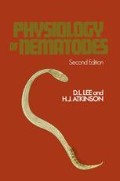Abstract
The cuticle of nematodes plays an important role in their physiology. It can be a simple or a complex structure, which varies from one genus to another and may differ in juveniles and adults of the same species. It is basically a three-layered structure and usually consists of cortical, median and basal layers (figure 2.1). This three-layered pattern occurs in the juvenile stages of most nematodes but in the adult cuticle modifications often occur (figures 1.3 and 2.2).4,5,6,23
Preview
Unable to display preview. Download preview PDF.
Author information
Authors and Affiliations
Copyright information
© 1976 D. L. Lee and H. J. Atkinson
About this chapter
Cite this chapter
Lee, D.L., Atkinson, H.J. (1976). Cuticle, Moulting and Growth. In: Physiology of Nematodes. Palgrave, London. https://doi.org/10.1007/978-1-349-02667-8_2
Download citation
DOI: https://doi.org/10.1007/978-1-349-02667-8_2
Publisher Name: Palgrave, London
Print ISBN: 978-1-349-02669-2
Online ISBN: 978-1-349-02667-8
eBook Packages: Biomedical and Life SciencesBiomedical and Life Sciences (R0)

